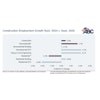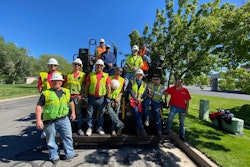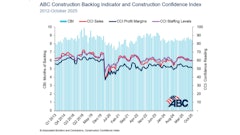
As many states deemed construction personnel essential, business leaders and HR managers had to adapt to changing business conditions over the past year rapidly.
This included creating and implementing new risk management strategies to reduce the spread of the virus but staying up-to-date with evolving payroll regulations and remaining compliant with industry-specific, local, state, and federal laws.
Looking ahead to the following stages of the pandemic, HR and business leaders need to focus on value-added tasks that will improve stabilizing the organization, instead of using manual or inefficient tools when processing information.
Unfortunately, this reduces efficiencies across the company and prevents the company from taking advantage of the expected 5.2% growth of the industry forecast this year.
While this output will be higher than the output level of 2019, it is still $1 trillion lower than what was expected without the occurrence of the coronavirus. This is why it will be critical for organizations to improve streamlining HR workflow, communication and other administrative tasks.
Using a modern platform to handle a company’s payroll tracking, attendance management and training to remain compliant gives HR managers more time to focus on what matters: the effectiveness, engagement, and performance of the employees. Automated tools can reduce opportunities for human error, while greatly accelerating and smoothing the compliance process. In addition, available solutions can scan data and policies for compliance with all applicable safety regulations to reduce the risk of fines, penalties and reputation harm that comes with non-compliance.
Using software that can manage payroll and attendance increases efficiencies and accuracy by automating the application of complex performance-based pay structures and addressing each employee’s varying pay among the diverse workforce.
Workforce management solutions (WFM) for construction companies are more than just labor scheduling and payroll management. Leveraging the use of a modern WFM solutions for HR professionals and managers can:
1. Enhance the management of workers
From a compliance standpoint, classification is potentially the biggest pitfall of a complex payroll system. Federal and state tax laws and employment regulations require distinct classifications for full-time employees, contractors, or contingent workers. That makes sense; a full-time worker with a complete benefits package will often be paid at a different rate than a worker hired through a third-party contingent hiring firm that doesn’t offer benefits. Likewise, both will likely receive a different rate than a freelance specialist brought in for a short-term project — an equipment operator training in handling machinery that a construction firm only needs on specific projects, for instance.
Accurately classifying each type of worker is not only essential for avoiding recordkeeping and payroll errors, but it’s also necessary for maintaining compliance with ever-changing regulations. While employers can cut labor costs considerably by claiming more independent contractors, doing so makes a significant impact on state and federal tax revenue and carries heavy penalties for misclassification.
2. Forecast ahead for future projects
Accurately tracking time, labor, and production across the project efficiently provides valuable data insight to labor effort and cost, by discipline in support of accurately estimating and bidding future jobs. To gather this information, field employees can utilize automatic time tracking systems, such as phone-in, mobile, tablet, and portable devices, to record activities when and where they occur.
The use of automatic time tracking systems can also reduce the occurrence of time theft that commonly occur. This includes:
- Buddy punching, in which two or more employees conspire to clock in or out on each other's behalf, making it appear as though they've put in more time than they have.
- Pay rate fraud, a form of embezzlement in which a member of the payroll team collaborates with an employee to essentially grant them an unauthorized pay raise.
- Timesheet fraud, in which an employee adds more hours to their timesheet than they worked.
- Supervisor fraud, in which a higher-level employee skims small amounts from other employees’ paycheck.
3. Communicate effectively
Communication platforms have replaced the worksite bulletin board to allow for timely open lines of communication between management, employees, and co-workers across projects and locations. Ensuring operations continue to run smoothly requires the use of various solutions like video conferencing and messaging software and targeted push notifications, employee feedback channels, and the ability to self-report possible worksite risks.
4. Improve data insights
A crucial part of budget forecasting is determining how much the labor, materials, and overhead that keep your business running will cost in the coming years. Having quick access to data on employee labor by skillset, expenses, scheduling, time off requests, past and projected overtime, and related factors allows a management team to envision just how much labor costs they will need to account for on a specific project. That information, in turn, informs everything from budgeting to hiring to equipment procurement. By assessing historical labor costing data and communicating closely with management teams, your financial professionals can draw a more accurate picture of the actual cost of doing business.
Some noteworthy labor costing KPIs might include:
- Total employee compensation
- Projected hiring and onboarding costs
- Worker productivity by shift
- Overtime by project
- Employee cost to billable revenue
- Employee absentee rates
For example, the diverse workforce needed for construction organizations requires specialized training, multiple shifts for tasks, and knowing where the crew is today and where they need to be for future projects. Manually tracking this information - in addition to payroll and schedules – can create both physical and financial risks as shifts can go unfilled and organizations cannot plan for future staffing needs across various projects.
Additionally, WFM solutions can assist with keeping employee’s certifications and training up to date. Over the past year, traditional training methods and large in-person groups have become obsolete as organizations have embraced learning management systems (LMS). Continued use of learning solutions that integrate into employees' records will reduce the need for HR and training managers to follow up on outdated and missing training constantly.
After a turbulent year, companies will need to leverage the capabilities of data to create and redefine operations to improve efficiencies. By focusing this effort within HR by streamlining key areas, organizations can capture critical insights to improve profit margins and future job costs.




















